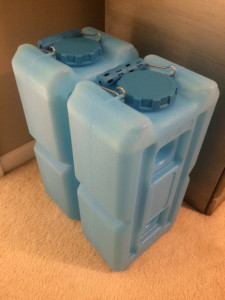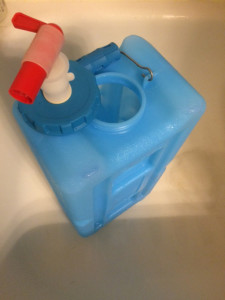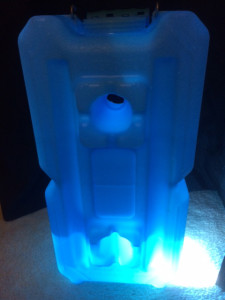I’ll be straight up with this one: I forgot to pay the water bill. As sure as I’m sitting here at my desk I can see the notice sitting next to me, the one that says something about paying by a certain date or a disconnect will happen. What can I say, we were out of town and then had family in town, life got busy and I blew it. This has never happened to me until today and it was and continues to be an eye opening experience with respect to water storage for SHTF.
I Screwed Up
Today my wife and I got home from work about the same time. I usually go inside and crack a cold beer, sit on the couch and flip on the local news to see who got shot/stabbed or similar. My wife doesn’t even come inside but instead starts to water her flower pots or whatever it is she does outside. She came in the house and went to the sink and then turned to me and said: “hey, our water isn’t working.” I stood there for a minute wondering how this was possible, did a water main break somewhere that we didn’t know about? After 30 seconds she stared a hole into my soul and said: “DID YOU PAY THE WATER BILL?” Ouch…that shook my memory and I immediately knew I had screwed up. I ran upstairs, called the water company and paid the bill. Thank you sir, but your water won’t be turned on until tomorrow. Yikes!
The GOOD News
We have plenty of water stored on site, at least I thought so. Cases and cases of bottled water which we rotate out frequently. 55 gallon drums of water which are treated and good for at least 5 years and additionally, 10 water bricks which I wrote about in a previous article.

Water Bricks on Standby Outside the Bathroom
Theory vs Application
I did the calculations and thought that we had a good bit of water on site, not even taking into account that I have a river close by which we could access (and I have tested for potability). I suppose I didn’t realize that when the taps really go dry just how fast what you have stored goes away. I mean I thought about it and thought I was prepared, but when I saw it in action it was shocking!
Currently the taps are dry at my house. We have pets that need water, we need to take showers and there are toilets to be flushed…and I’ll be needing some coffee in the A.M. Before you get started I know what you are thinking, when T-SHTF less showers will be taken and water conservation will be at an all time high, but for now we can relax a little and use a bit more for luxury type functions (showers?).
The Plan
I decided that we should use the water bricks as they are the easiest to transport and utilize. My wife and I both smelled pretty terrible from previous gym workouts, needed a shower and toilets needed flushed as I didn’t plan on utilizing a hole in the yard just yet. On a side note I thought we had one of those hanging camp showers, turned out we didn’t (maybe I need to buy one).

Water Brick in the Tub
The shocker was this: just how fast the water goes away. We almost entirely drained one water brick after both taking rather quick showers using sparse amounts of water and refilling the toilet tank after a flush.

1 Toilet Tank Refill, 2 Showers, What Remained
Cold Water to the FACE
I keep all of our water storage in the basement. I have to tell you that splashing that cold water on me while taking a shower was definitely an “ah ha” moment. It was cold, almost ice bucket challenge cold! At first I tried using the spigot that came with the water bricks to regulate the flow but that was useless, I just opened the top and dumped it on me in quick bursts. As someone who has taken many cold / field showers, that was VERY cold indeed.
The Bottom Line
This little experience was a real eye opener. Here we are barely 5 hours into a “no water” experience and we are through 1 of our 10 water bricks via normal operations and that doesn’t even account for cooking food, hygiene, animals etc. I had always estimated 2-4 gallons per person per day but when seeing it in action, after only one day, it has been a real eye opener. My only advice would be this: when you think you have enough water stored…GET MORE.
**Update**
Another 5 gallons used this morning for various tasks: hygiene, toilet use, dish washing, general consumption. Bear it mind it hasn’t even been a full 24 hours! Water goes very quickly and you use it for more things than you might realize, something I’m finding out right now at the house.
One other point: portability. I’m glad I have the water bricks and 1 gallon jugs, makes hauling stuff up from the basement easier. If all I had were large barrels it would mean pumping the water out into another bucket etc etc.









16 comments
Skip to comment form
I use, according to my water bill, around 2000-4000 gallons per month. (depending on if I brew and water the garden), additionally I live alone, so that is for one person. Hence when (not if) the SHTF I can probably cut that back a little. OHHHHH maybe 1/10, so that’s lets say 300 a month, or 10 gallons a day…. Personally there is no way I can afford 60 “water bricks” (5 gallon size) for only 1 month of water. Or can I afford 6 barrels for water again for one month. Not only that, think of the storage room for 720 “bricks” or 72 barrels for that magic one year supply. Outsourcing that reoccurring supply will be the ONLY way to go.
NRP
Author
NRP
Agree, you can store what you want but there had better be another source for when the current supply runs dry.
I resently discovered that my local garbage company has dropped 3- new/ clean ,wheeled, plastic cans. 1- 33 gallons for raw garbage, 1- 64 gal for recycle and a 98 gallon for yard trash pick-up. The 64gal and 98 gal equils
160 gallons. thats 80 days supply for my wife and me. thank you garbage company. all at no costn to me. Don’t forget get 33 gallons or larger metal garbage cans. line them with 6- mil yard waste bags. The soft plastic cans split when stored in the sun.
I can totally relate to forgetting to pay that bill! I’m more guilty – have done it twice! Good excuse for a survival drill, right?
Did you forget about your hot water heater? Draining some of that into a bucket may have given you at least a tepid shower versus cold! And of course you could have heated some water on your stove, right?
With limited space for water storage, multiple ways to filter water is essential!
Author
Totally forgot about the hot water heater, thanks for bringing that up.
Hey pj
Look into a curb key. Handy to have around
Author
Definitely gotta have one! For SHTF that is…currently I could get arrested for messing with things.
A family of four has to plan for roughly 1,000 gallons per month as a minimum. Add in pets or livestock and you will have to up that. At 1,000 gallons, you are looking at 18 each 55 gallon drums – naturally it will not all be in 55 gallon drums but the rough space requirement will be the same. Honestly very few will have the space required to store one month of water much less a year.
My recommendation would be to have a means of replenishing water – shallow or deep well, rain catchment, or close by surface water. On a close by water source, the viability will be the distance – in this case we are talking about 256 pounds of water every day! Ever attempted walking any distance with a 5 gallon bucket of water? Yes, it is only 40 pounds but it is awkward to carry. How many 1/2 mile trips do you think you could make in a day?
Not to be Debbie Downer here but water is going to be the biggest problem we all will probably face. The easiest fix is some type of catchment system and unless you live in a desert it will help. Wells will be a choice for some but those in cities can probably forget that option. Whatever it is, it has to be layered.
I am not totally comfortable with my water situation and I have a deep well that I can run with a generator, a windmill shaft pump well mainly for the livestock, and a shallow shaft pump well. I also have rain catchment systems on the house and two barns, as well as water stored in various forms (bottles, bricks, jugs, drums, etc). There is plenty of surface water within 1,000 yards also. Even then there is so much that can go wrong that it is hard to find a comfort level with water.
Another thing to consider, it will take time to adjust our water usage post-SHTF. We take it for granted today and immediately after losing it at the tap we will still waste plenty of it. For example, PJ, you do not have to refill the tank in order to make a toilet flush – you will use less water by pouring the water directly into the bowl until it goes down, depending on the type of toilet it will be about 1/2 of what filling the tank will be.
Author
Maj
Great advice on a catchment system. Assuming one has the means to filter the water obtained via rain catchment, what are your thoughts on the construction of a barrel? I’ve seen many types of designs online, most which attempt to keep the system from being a bug breeding ground. Any thoughts?
PJ if you use a kiddie pool to catch rain water or the roof of house, if you put bleach in the water to kill bacteria it is fit to drink? and if it is how much bleach would you use? Also would a Brita with a filter clean the waer safely to drink? Now if you have no waer for 2 to 5 yrs, what would you do? I know in the winter time snow would be the source of water, correct?
Probably plenty of books already written on rain catchment systems, so not really sure I can answer everything right here in one post. As far as the barrel, I prefer food grade plastic – it is easier to tap, work, and repair in some cases. It also seals better than other barrels and is typically cheaper (sometimes free if you have the time and desire to clean them).
As far as the system, type, etc. You really need to determine what your use for the water you catch is going to be – irrigation, livestock, flushing toilets, etc can be a really simple system and who cares if there are some bugs growing in it? Naturally, if you are going to use it for cooking, drinking, taking a bath, etc. you will probably want a more elaborate system. Unless you are picking up chemicals or metals from your roof, in many cases, straining the water and boiling will take care of what could hurt you. Since I am not big on wasting the time, energy and effort that is required to boil water daily – I went elaborate on one of the systems and not so elaborate on the other two.
Not so elaborate = 55-gal food grade drums, gutter system, in-feed screen (simple) with the drums attached in series. I still treat the water somewhat with bleach and to keep anything from growing in the drums. Let the water flow, treat with bleach, and rotate.
Elaborate = 55-gal food grade drums, gutter system, in-feed screen (simple), in-feed bypass, 12 gpm mesh filter behind the catch drum leading into the drums in series, finishing up with a 15 gpm / .2 micron filter before the final barrel in series. I have it set up where I can remove the final drum for storage and replace it with an empty drum on this system. The 15gpm / .2micron filter is expensive and not necessarily a necessity – it will handle about 200,000 gallons before the filters need replacing. Also, the in-feed bypass is left open until 5 to 10 minutes into a rain event to allow time for the roof to flush. I still put bleach in each drum in series at regular intervals but mainly dependent on time between rain events.
Every drum in each of my catchment systems has a spigot tapped into the bottom side of the drum in order to allow them to be drained easily, except for the final drum in the “elaborate system”. You do have to rotate the water regularly, so have a plan for what you are going to do with it when you do not really need it. Your storage space and use will play a big part in how big or how small your system should be.
Really can be as simple of complex as you want or need. Plan to keep your gutters clean though and flush them out twice a year. Post-SHTF you will just have to let the rain flush it.
Well, I’m a Key West conch, up until 1935 when the water main was brought down 125 miles from south Miami, all the locals relied on cisterns (we’re talking about 5,000+ locals back in the day), catching rain water off their roofs. They built cisterns or had wood barrels to store it in. With today’s filtering systems and different ‘life straws’ this could be an easy alternative. Divert your gutters into some sort of containers and check into different types of filters. Look up Lifestraws, we bought 2 ‘Family’ size, it will filter 18,000 gallons each, yes, 18,000 gallons, enough for a family of 5 for 2 years ! ! Less than $100. Good luck, Molon Labe
I am an urban dweller, age restricted community of single family homes with reasonable HOA restrictions – reasonable unless the SHTF and you need an independent supply of water, need to raise chickens and rabbits, grow a little food, etc.
But water is always the most urgent prep and as stated elsewhere, it is the hardest to store adequate quantity for even a few days in an emergency.
I considered dipping and hauling water from pools in the neighborhood, but the owners might have better uses for their water, so that is not a dependable source.
But when thinking about pools, I realized that portable kiddie pools, or even larger inflatable or plastic lined pools hold a LOT of water. Since my covered patio is ten foot wide, I need a pool that will sit on the concrete slab. So, it’s off to Walmart to buy a ten foot diameter by about 42 inch high pool.
At Walmart and some other mail order sources I find pools in the $300 to $400 dollar range that hold an amazing 1,300 gallons of water when filled to the top.
The pool, with a plastic cover to keep bugs and dirt out, and a siphon pump that comes with most pools, I am fixed up for quite awhile at very little cost.
This is not technically potable water but by golly, I would drink it before I would die of dehydration. And all of my other water needs are taken care of for a long time.
Think about it. Where else could you get 1,300 gallons of life saving water for that price.
Not sure what is wrong with the information I gave. I filled all of the * blanks. Please tell me what is wrong. Thanks
So I have 1 gallon of water per person in my house for 3 days. You can always store more but I would think that should be the minimum, correct?
It is better than nothing but 72 hours goes quick. I would shoot for 7 days being a minimum and bugging out in your vehicle with no less than 72 hours worth. However, you can ask 10 different people and get 10 different answers.